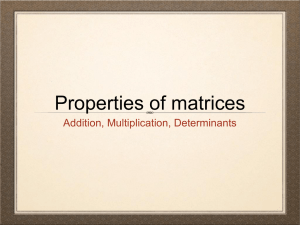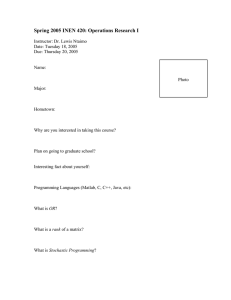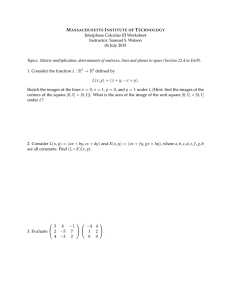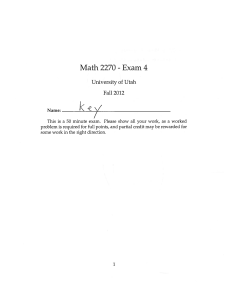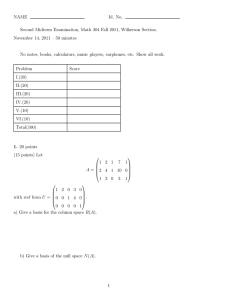Matrix Primer Add two 3x3 matrices
advertisement
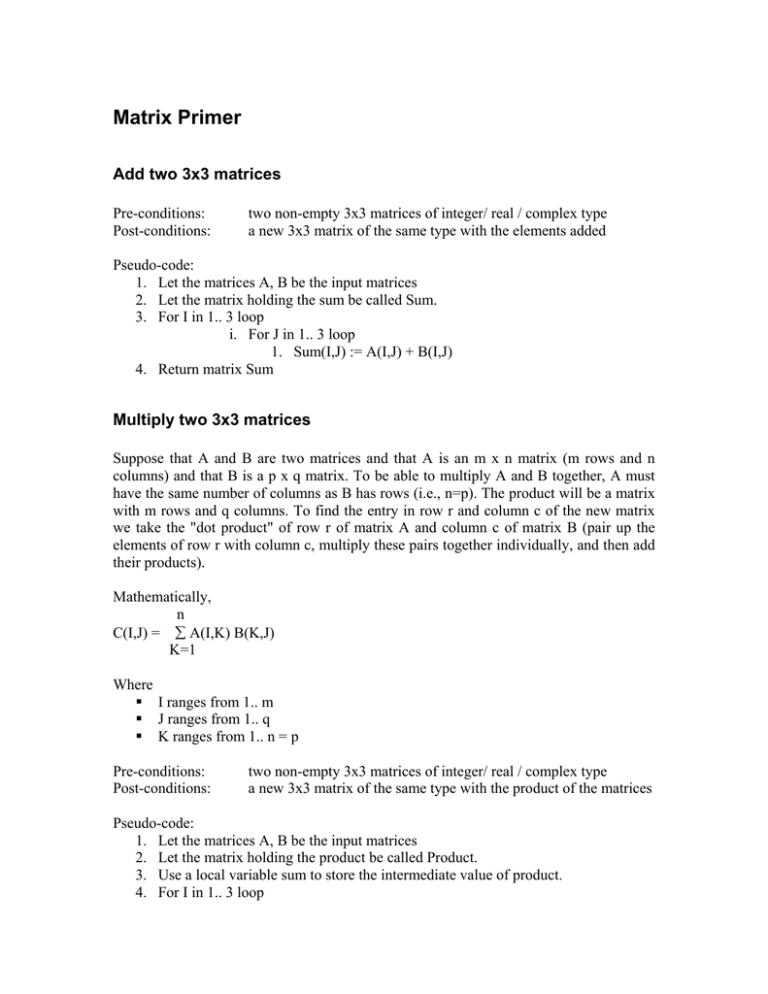
Matrix Primer Add two 3x3 matrices Pre-conditions: Post-conditions: two non-empty 3x3 matrices of integer/ real / complex type a new 3x3 matrix of the same type with the elements added Pseudo-code: 1. Let the matrices A, B be the input matrices 2. Let the matrix holding the sum be called Sum. 3. For I in 1.. 3 loop i. For J in 1.. 3 loop 1. Sum(I,J) := A(I,J) + B(I,J) 4. Return matrix Sum Multiply two 3x3 matrices Suppose that A and B are two matrices and that A is an m x n matrix (m rows and n columns) and that B is a p x q matrix. To be able to multiply A and B together, A must have the same number of columns as B has rows (i.e., n=p). The product will be a matrix with m rows and q columns. To find the entry in row r and column c of the new matrix we take the "dot product" of row r of matrix A and column c of matrix B (pair up the elements of row r with column c, multiply these pairs together individually, and then add their products). Mathematically, n C(I,J) = ∑ A(I,K) B(K,J) K=1 Where I ranges from 1.. m J ranges from 1.. q K ranges from 1.. n = p Pre-conditions: Post-conditions: two non-empty 3x3 matrices of integer/ real / complex type a new 3x3 matrix of the same type with the product of the matrices Pseudo-code: 1. Let the matrices A, B be the input matrices 2. Let the matrix holding the product be called Product. 3. Use a local variable sum to store the intermediate value of product. 4. For I in 1.. 3 loop i. For J in 1.. 3 loop 1. Sum := 0; 2. For K in 1 .. 3 loop a. Sum := Sum + A(I,K) * B(K,J); 3. End K loop 4. Product(I,J) := Sum; ii. End J loop 5. End I loop 6. Return matrix Product Transpose a 3x3 matrix Pre-conditions: Post-conditions: A non-empty 3x3 matrix A new 3x3 matrix of the same type with the elements in rows and columns exchanged Pseudo-code: 1. Let the input matrix be A 2. Let the matrix holding the transpose be called Transpose. 3. For I in 1 .. 3 loop i. For J in 1.. 3 loop 1. Transpose(I,J) := A(J,I) 4. Return matrix Transpose Inverse of a 3x3 matrix The inverse of a 3×3 matrix is given by: We use cofactors to determine the adjoint of a matrix. The cofactor of an element in a matrix is the value obtained by evaluating the determinant formed by the elements not in that particular row or column. We find the adjoint matrix by replacing each element in the matrix with its cofactor and applying a + or - sign as follows: � and then finding the transpose of the resulting matrix The determinant of an n-by-n matrix A, denoted det A or |A|, is a number whose value can be defined recursively as follows. If n=1, i.e., if A consists of a single element a11, det A is equal to a11; for n > 1, det A is computed by the recursive formula where sj is +1 if j is odd and.1 if j is even, a1j is the element in row 1 and column j , and Aj is the n . 1-by-n . 1 matrix obtained from matrix A by deleting its row 1 and column j . For a 3x3 matrix, the formula can be determined as: Preconditions: A 3x3 invertible matrix Postconditions: A new 3x3 matrix which is the inverse of the input matrix Pseudocode: 1. Let the input matrix be A 2. Let the cofactor matrix be Cofactor 3. Let Determinant be the variable used to store the determinant 4. For I in 1.. 3 loop a. Compute the indices of the elements to compute the determinant using the formula: i. I1 := (I + 1) Rem 3. If I1 = 0 then I1 = 3 ii. I2 := (I + 2) Rem 3. If I2 = 0 then I2 = 3 b. For J in 1..3 loop i. C ompute the indices of the elements to compute the determinant using the formula: 1. J1 := (J + 1) Rem 3. If J1 = 0 then J1 = 3 2. J2 := (J + 2) Rem 3. If J2 = 0 then J2 = 3 ii. Cofactor(I,J):=A(I1,J1)*A(I2,J2)- A(I1,J2) * A(I2,J1) 5. Compute determinant as Determinant := A(1,1)*Cofactor(1,1) + A(1,2)*Cofactor (1,2)+ A(1,3)*Cofactor (1,3) 6. Compute the transpose of the Cofactor matrix 7. For I in 1.. 3 a. For J in 1..3 i. Inverse(I,J) := Cofactor(I,J) / Determinant 8. Return Inverse Note: The method for computing the cofactor automatically generates the required signs in the cofactor matrix.

